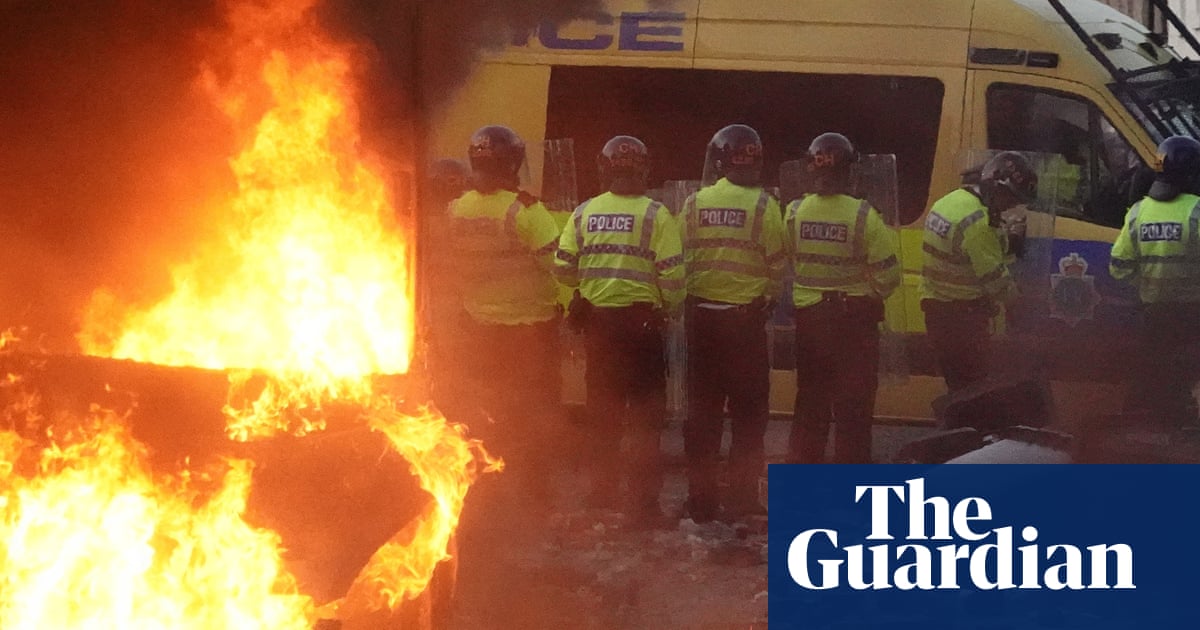The riots that swept the UK last summer had more in common with race riots in the 1950s in Nottingham and in Notting Hill, west London, than they did with disorder that broke out in 2011, researchers have said.
Violence first erupted on the streets of Southport after the murder of three young girls, Elsie Dot Stancombe, seven, Alice da Silva Aguiar, nine, and Bebe King, six, at a Taylor Swift-themed dance class in theMerseysidetown. The perpetrator, Axel Rudakubana, was later jailed for a minimum of 52 years.
Therioting startedon 30 July, a day after the attack, following misinformation being circulated online claiming the attacker was a Muslim asylum seeker. The claim was pushed by far-right social media accounts.
The disorder then spread across England and Northern Ireland, with riots in cities and towns including London, Manchester, Hartlepool, Sunderland, Liverpool, Blackpool, Rotherham and Belfast.
It came to an end just over a week later after dozens of often large counter-demonstrations across the country.
While the riots have often been referred to as “far-right protests”, researchers have found that the situation on the ground was actually more complex.
The pre-print paper looked at three case studies – Bristol, Hanley inStoke-on-Trent, and Tamworth. It used interviews and multiple secondary sources to understand what had happened and who was involved.
“Some people call these protests far-right protests,” said the lead author, John Drury, a professor of social psychology at the University of Sussex, “but were they protests? Well, they didn’t take the usual form of protest. I mean, maybe you might call them some kind of direct action.”
In the paper, the researchers said: “Our evidence suggests that participants in the three riots comprised a ‘racial’ majority (ie white people) seeking to attack minoritised ethnic groups. As such, these riots were unlike the waves of urban riots in the UK in the 1980s and 2011 (which involved an ethnic minority against authority).
“Arguably the summer riots of 2024 had more in common with the ‘race’ riots in Notting Hill and Nottingham in 1958 and those in Liverpool and Cardiff in 1919.”
The violence in the summer of 1958 began in the St Ann’s area of Nottingham, and was followed by similar disorder in Notting Hill, fuelled by tensions over increased migration from the Caribbean. Violent attacks were carried out by groups of white men, with them using weapons against Black people. Black homes were also targeted in arson attacks.
In another spate of violent disorder in spring and summer of 1919, at a time of postwar job shortages, minority communities in port cities including Glasgow, Cardiff and Liverpool were targeted in racist attacks.
The paper said that “events largely comprised attacks rather than protests”, pointing to “the length of the collective actions, the relative absence of protest event paraphernalia and the unprovoked nature of the violence which at least half of those in each anti-immigrant participants engaged in.”
Those attending the various “protests”, the researchers also found, were “not just far-right activists or individuals affiliated with football ‘risk’ groups, but also non-affiliated individuals who were anti-immigration, people who were anti-police, and also ‘bystanders’ who were there to see or record exciting events or who joined in spontaneously”.
While this was common from data across the three riots, “proportions are hard to estimate”, the paper said. “There is insufficient evidence to suggest that the anti-immigrant crowds were homogeneous or that all present were equally committed to violent racist attacks.”
Sign up toHeadlines UK
Get the day’s headlines and highlights emailed direct to you every morning
after newsletter promotion
“This phrase far right was used about the events,” Drury said. But he added: “Possibly it’s a step from that then to say they’re all equally racist.”
Making assumptions about those taking part could cause issues in that policymakers “assume that the same remediation mitigation policies will work for all of them”, Drury said. “This is what the government started to do, I think, just like they made many assumptions in 2011 about who took part and why they took part, and rapidly rolled out policies that were found to be ineffective and inappropriate.”
He gave the example of the then government’s troubled families initiative, which was introduced incorrectly and imagined that everybody who had taken part had “some kind of problem with their family upbringing”.
Drury added: “Labelling them all as if they’re all far right, might actually drive them into the far right.”
The research also found that at least four different parties were involved in the events – the anti-immigrant participants, police, counter-protesters, the targets of the actions – asylum seekers and Muslims – while local “community defenders” were also present in Hanley.
“I guess what was striking was the differences between the three [Hanley,Bristol, and Tamworth],” Drury said, with different levels of violence and different scales of counter-protest. “I think that was a striking thing, the variety.”
He said that while “we might talk about them as all the same kind of event”, to fail to understand the nuances could cause issues in future prevention and policymaking, because “they were actually quite different”.
